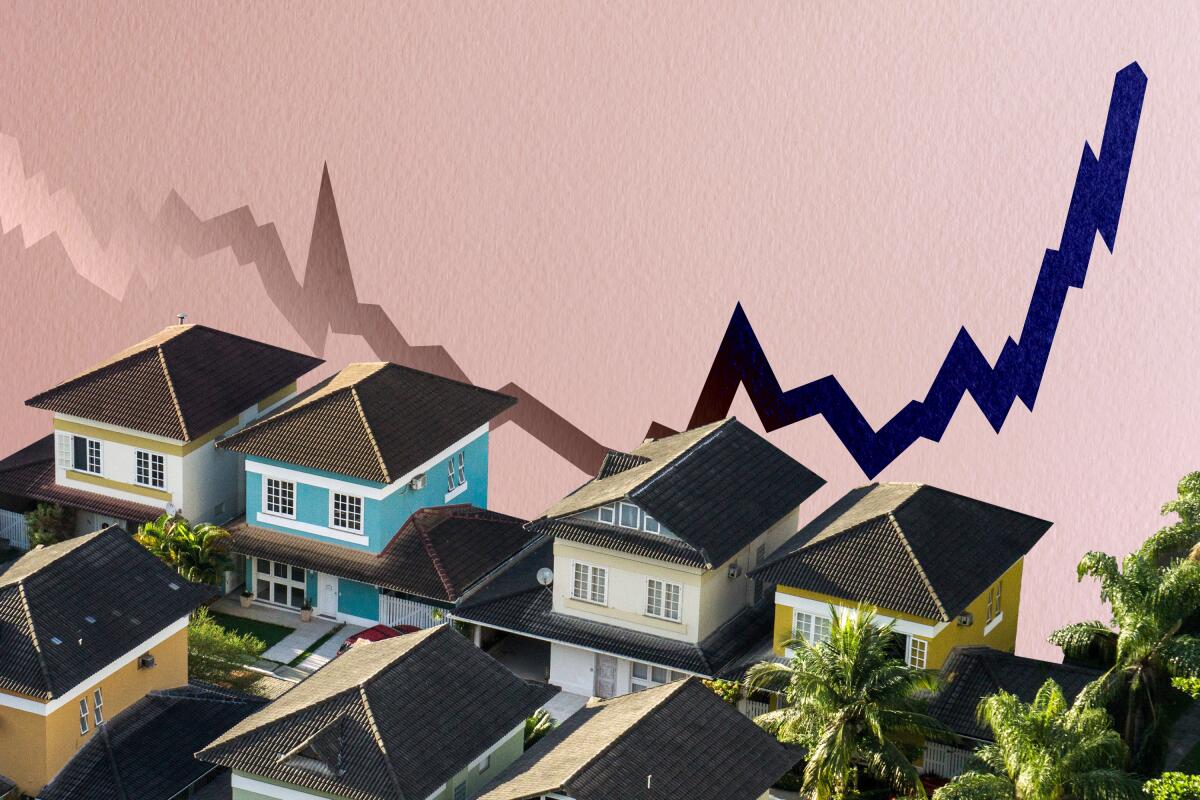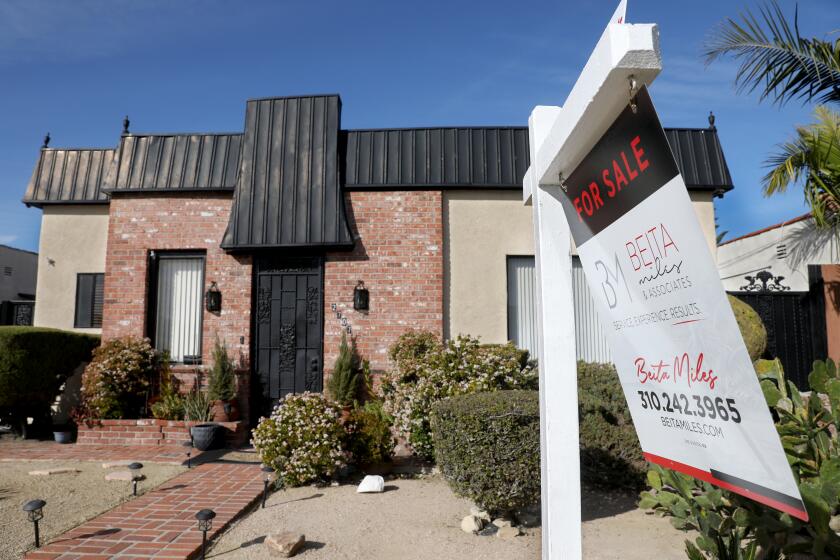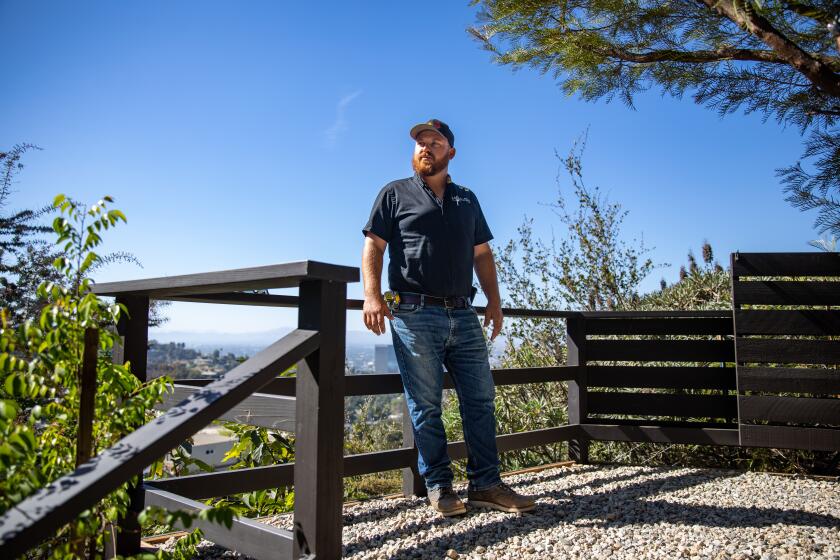Buying a home? Get ready for a 6% mortgage

- Share via
The 6% mortgage is back.
For the first time since 2008, according to a widely watched survey, the average interest rate on a 30-year fixed home loan climbed above 6%, marking a dramatic explosion in borrowing costs.
The jump — the latest in a series of mortgage rate increases this year — has the potential to further pump the brakes on a slowing housing market and make it more likely home values will decline.
“It shrinks your buying ability,” said Jeff Lazerson, president of brokerage Mortgage Grader. “A lot of borrowers are saying: ‘Forget it.’”
Today’s environment is starkly different from this time last year.
Then, the Federal Reserve’s easy money policies helped drive average rates below 3%. Homes flew off the market in days. Home prices soared.
But in recent months, inflation and the Federal Reserve’s efforts to fight it have sent rates sharply higher and forced both sellers and buyers to adjust to a new reality.
With interest rates rising, home buyers may be more tempted by ARMs as a way to cut costs. Here are the potential pitfalls to consider.
With buyers able to afford less, many have called it quits. Home sales are plunging and home values are showing signs of faltering.
In July, Southern California home sales fell 35% from a year earlier, according to real estate firm DQNews. The six-county region’s median price — the point at which half the homes sold for more and half for less — slipped to $740,000 in July. That’s 2.6% below the all-time peak this spring.
July’s median, bolstered by strong demand earlier in the year, was 8.8% higher than a year earlier. But in April, the Southern California median price was nearly 17% higher than a year earlier.
On Thursday, mortgage giant Freddie Mac reported that the average rate on a 30-year fixed home loan clocked in at 6.02%, up from 5.89% the previous week and 2.86% a year earlier.
Compared with a year earlier, an increase to 6.02% adds $1,105 to a monthly mortgage payment if you put 20% down on a $740,000 house.
Purchasing a $1-million house? That’ll be $1,494 more a month.
Many would-be buyers simply can’t afford such increases, and a growing number of economists expect Southern California home prices to fall in 2023 compared with 2022, though by less than 10%.
Few, if any, major analysts predict price declines similar to those during the Great Recession, when Southern California values plunged 50% over two years.
Prices collapsed then because there was a wave of forced selling at a loss, through foreclosures and short sales.
During this latest housing boom, lending standards were much tighter, and many homeowners choose not to sell in a soft market if they don’t have to.
Underscoring that, the number of new listings hitting the market each week is down compared with a year earlier, both in Southern California and elsewhere around the country.
In Los Angeles County, during the four weeks that ended Sept. 4, there were 31% fewer new listings than a year earlier, according to real estate brokerage Redfin.
“Inventory remains inadequate,” Freddie Mac chief economist Sam Khater said in a statement released with Thursday’s survey. “This indicates that while home price declines will likely continue, they should not be large.”
The average rate on a 15-year fixed mortgage, popular with refinancers, rose to 5.21%, up from 5.16% the previous week and 2.12% a year earlier, according to the Freddie Mac survey.
Where rates head from here isn’t entirely clear. In large part, that’s because the interest that borrowers pay reflects what investors are willing to pay for mortgages repackaged on the secondary market.
Factors influencing that include Federal Reserve policy and the trajectory of both inflation and the overall economy.
Black widow spiders, secret rooms, human skulls. Structural assessors see the underbelly of L.A. real estate — and have the stories to prove it.
With uncertainty surrounding those factors, rates have been volatile in recent months. After nearing 6% in June, rates retreated. They even dipped below 5% the first week of August, and some agents and industry analysts reported a slight pickup in demand.
Keith Gumbinger, vice president of research firm HSH.com, said rates have since risen in part because the labor market has remained strong and investors see less of a chance for an immediate recession and a greater chance inflation will stay elevated.
Freddie Mac’s survey covers mortgages for people with excellent credit who put 20% down, meaning that many current home shoppers should expect higher rates than the survey’s average.
The last time rates were this high was in November 2008, when the 30-year mortgage averaged 6.04%.
Jordan Levine, chief economist with the California Assn. of Realtors, said rates should stay above 6% this year, and might climb to 6.5%, which gives him more confidence that California home prices will be modestly lower next year compared with 2022.
Although 6% rates aren’t high historically, Levine noted that today’s consumer must purchase in a market with prices set when rates were half of what they are today.
“It’s a big jump,” Levine said. “We haven’t seen this rapid increase in rates except for times of really high inflation.”
More to Read
Inside the business of entertainment
The Wide Shot brings you news, analysis and insights on everything from streaming wars to production — and what it all means for the future.
You may occasionally receive promotional content from the Los Angeles Times.











